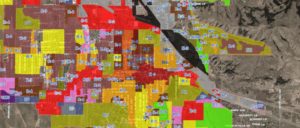By Cari Kimball

When MEIC was formed in 1973 to give a voice to Montana’s environment at the State legislature, one of the organization’s priorities was establishing and defending sensible land use planning and zoning measures that also provided environmental protections. At their most basic level, land use laws are intended to protect public health, safety, and the general welfare of our communities, though it doesn’t always work out that way.
Good zoning measures can reduce traffic congestion, prevent wildlife habitat fragmentation, protect irreplaceable agricultural soils, and limit septic systems’ contributions to nutrient pollution in our waters. Mixed-use, higher-density zoning in Montana towns and cities has the potential to foster walkability and affordable public transportation options, while saving taxpayers money on infrastructure costs with, for example, fewer sewer mains, water mains, and roads to build and maintain. All told, land use laws have huge implications for our day-to-day quality of life and even our ability to wean ourselves off fossil fuels.
Ideally, planning and zoning laws reduce conflict between individuals in a community and prevent them being a nuisance to one another. For example, a distractingly noisy widget factory sited beside an elementary school would probably degrade the learning environment for kids.
Unfortunately, exclusionary zoning has also been used in discriminatory ways to prevent people of color or lower incomes from living in the same neighborhoods as white or wealthier people. For example, in the 1910s, local and federal officials across the U.S. began to promote zoning ordinances that would reserve certain neighborhoods for single-family homes, which were often only affordable for white people because of discriminatory lending practices. This also prevented the construction of more affordable apartments or denser developments in those neighborhoods. During the same era, many residences also had deeds that prohibited occupancy by people of color. Today’s less exclusionary zoning practices are driving skyrocketing real estate prices through creation of large minimum lot sizes and single family residential zones that often require lots of space for parking multiple vehicles.
Zoning, however, can also have very important benefits. Several of MEIC’s victories have hinged on zoning. In 2010, the Montana Supreme Court ruled in favor of MEIC and partners to block construction of the coal-fired Highwood Generating Station in Cascade County. The rationale was that the area was zoned for agricultural use, and an authorization to construct a coal plant would have required changing the zoning to heavy industrial use, eliminating agricultural potential and ultimately constituting illegal spot zoning. In today’s fights, zoning could prevent opencut mines from draining neighboring wells and disrupting neighbors with constant noise and dust. Zoning could prevent a proposed methane gas plant from poisoning airsheds, damaging rivers and watersheds, and creating constant noise and hazards for nearby neighbors. Land use laws have the potential to make or break our access to a clean and healthful environment.
During the 2021 Legislative Session, we saw several attempts to minimize the influence local communities can have on local land uses, and generally to shrink or dilute Montana’s land use laws. Thankfully, the worst ideas were rejected. However, we anticipate more of the same at the 2023 session. Too many legislators in Montana trust corporate real estate developers and mining industry magnates to make better decisions about public health, safety, and the general public welfare than actual members of our community. They subscribe to a belief that immediate profit potential determines the highest and best use of land.
But Montanans know first-hand how the Copper King model of governance worked: what’s best for short-term corporate profits is rarely what’s best for Montanans. Indeed, before people of European descent came to this part of the world and applied their values about the “best” way to use land, Indigenous people were living in relationship with the land, developing lifeways and land uses based on extensive knowledge. We would do well to better incorporate more traditional knowledge into modern land use practices.
That’s why MEIC will continue to fight for land use protections that promote sustainable, diverse, thriving communities for all people and ecosystems, not toxic wastelands and soulless suburban sprawl that benefits only the wealthy few.
If you’re interested in land use issues and want to be involved, contact MEIC Campaigns and Advocacy Director Melissa Nootz at mnootz@meic.org.
This article was published in the March 2022 issue of Down To Earth.

